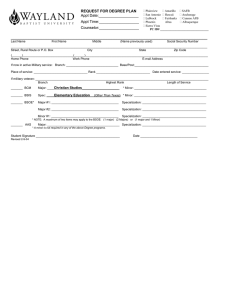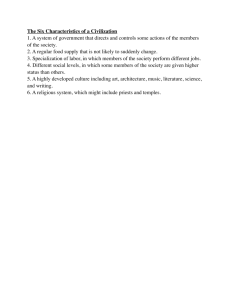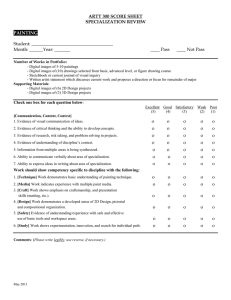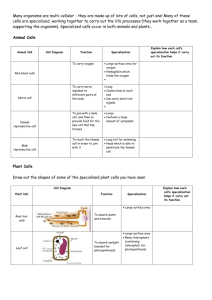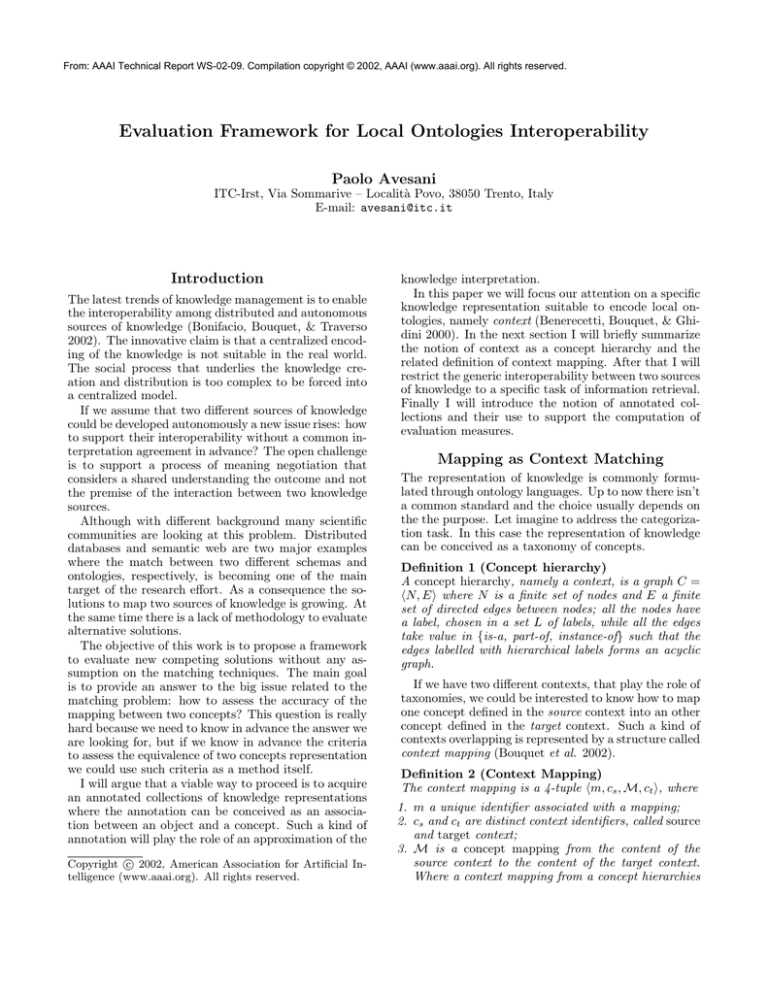
From: AAAI Technical Report WS-02-09. Compilation copyright © 2002, AAAI (www.aaai.org). All rights reserved.
Evaluation Framework for Local Ontologies Interoperability
Paolo Avesani
ITC-Irst, Via Sommarive – Località Povo, 38050 Trento, Italy
E-mail: avesani@itc.it
Introduction
The latest trends of knowledge management is to enable
the interoperability among distributed and autonomous
sources of knowledge (Bonifacio, Bouquet, & Traverso
2002). The innovative claim is that a centralized encoding of the knowledge is not suitable in the real world.
The social process that underlies the knowledge creation and distribution is too complex to be forced into
a centralized model.
If we assume that two different sources of knowledge
could be developed autonomously a new issue rises: how
to support their interoperability without a common interpretation agreement in advance? The open challenge
is to support a process of meaning negotiation that
considers a shared understanding the outcome and not
the premise of the interaction between two knowledge
sources.
Although with different background many scientific
communities are looking at this problem. Distributed
databases and semantic web are two major examples
where the match between two different schemas and
ontologies, respectively, is becoming one of the main
target of the research effort. As a consequence the solutions to map two sources of knowledge is growing. At
the same time there is a lack of methodology to evaluate
alternative solutions.
The objective of this work is to propose a framework
to evaluate new competing solutions without any assumption on the matching techniques. The main goal
is to provide an answer to the big issue related to the
matching problem: how to assess the accuracy of the
mapping between two concepts? This question is really
hard because we need to know in advance the answer we
are looking for, but if we know in advance the criteria
to assess the equivalence of two concepts representation
we could use such criteria as a method itself.
I will argue that a viable way to proceed is to acquire
an annotated collections of knowledge representations
where the annotation can be conceived as an association between an object and a concept. Such a kind of
annotation will play the role of an approximation of the
c 2002, American Association for Artificial InCopyright °
telligence (www.aaai.org). All rights reserved.
knowledge interpretation.
In this paper we will focus our attention on a specific
knowledge representation suitable to encode local ontologies, namely context (Benerecetti, Bouquet, & Ghidini 2000). In the next section I will briefly summarize
the notion of context as a concept hierarchy and the
related definition of context mapping. After that I will
restrict the generic interoperability between two sources
of knowledge to a specific task of information retrieval.
Finally I will introduce the notion of annotated collections and their use to support the computation of
evaluation measures.
Mapping as Context Matching
The representation of knowledge is commonly formulated through ontology languages. Up to now there isn’t
a common standard and the choice usually depends on
the the purpose. Let imagine to address the categorization task. In this case the representation of knowledge
can be conceived as a taxonomy of concepts.
Definition 1 (Concept hierarchy)
A concept hierarchy, namely a context, is a graph C =
hN, Ei where N is a finite set of nodes and E a finite
set of directed edges between nodes; all the nodes have
a label, chosen in a set L of labels, while all the edges
take value in {is-a, part-of, instance-of} such that the
edges labelled with hierarchical labels forms an acyclic
graph.
If we have two different contexts, that play the role of
taxonomies, we could be interested to know how to map
one concept defined in the source context into an other
concept defined in the target context. Such a kind of
contexts overlapping is represented by a structure called
context mapping (Bouquet et al. 2002).
Definition 2 (Context Mapping)
The context mapping is a 4-tuple hm, cs , M, ct i, where
1. m a unique identifier associated with a mapping;
2. cs and ct are distinct context identifiers, called source
and target context;
3. M is a concept mapping from the content of the
source context to the content of the target context.
Where a context mapping from a concept hierarchies
Cs = hNs , Es i to Ct = hNt , Et i, is a tuple of relations
each of which is a subset of Cs × Ct .
The mapping between two contexts can be considered a way to assess the similarity among the concepts
defined autonomously by two sources of knowledge.
Information Retrieval
The notion of similarity is always related to a given
target or goal. For this reason we have to specify in
advance what are the tasks related to the context similarity assessment. We could identify at least two:
• Concept-based Retrieval. We can design a scenario where given a context C1 a concept s ∈ C1
is selected as representative of the meaning that a
seeker is looking for; the goal in this scenario is to
detect in a context C2 a concept p ∈ C2 that has the
same meaning of s, i.e. the document classified under
the node p would the same classified under the node
s.
• Context-based Retrieval. A different scenario can
be conceived where a knowledge engineer is going to
design a context to be deployed as categorization taxonomy; given a sketch of such a context the knowledge engineer could be interested to find a past developed context for revision or completion purposes.
The two tasks illustrated above address different notions of similarity. For example the former could promote as most similar a mapping where all the concepts
of a context C1 are projected on a single concept of a
context C2 . The same mapping could not be considered
a good approximation of the context similarity because
in this case a non injective mapping should be preferred.
In the following we will focus on the concept-based
retrieval task.
Approaching Context Matching
Before to introduce a methodology of evaluation we
need to detail more the interoperability model of the
concept-based retrieval scenario. The interaction between a seeker and a provider implements a meaning
negotiation process that can be of two types:
• Supervised. In this case the similarity assessment
can refer both the concepts defined by the contexts
and the document classified under the given contexts.
• Unsupervised. In this case the similarity assessment can refer only the concepts as defined by the
contexts without taking advantage of the information that could derive from the documents classified
under a given context.
In the following we will focus only on the unsupervised scenario.
Annotated Context Collection
Although we have excluded the possibility to refer the
documents classified under the given contexts it doesn’t
mean that we give up to exploit them. As mentioned in
the introduction the big issue is to acquire in advance
the right mapping between two concepts that belong to
different contexts.
The trivial solution could be to acquire in advance the
optimal mapping taking advantage of an expert that interprets both the contexts. But this approach suffers of
at least a couple of drawbacks. The former is concerned
with the scalability: what about the expert when the
size of the contexts increases? what about the combinatorial explosion when the number of contexts increases?
The latter is even worse. The idea that an expert can
provide the optimal mapping between two contexts is a
little contradictory. We have made the assumption that
the two contexts are autonomously defined then two interpretation schemas apply not necessarily covered by
a single user.
It should be evident that the elicitation of the optimal
mapping can be achieved only as a result of a collaborative effort of many experts that through a process
of negotiation achieve a common agreement. This kind
of approach has been applied by the community of the
natural language processing to address the evaluation
of the message understanding task (Hirschman 1998).
Here I would like to propose an approach that preserves the initial assumption of autonomy and at the
same time doesn’t require a cognitive overload not sustainable by a real expert.
The basic idea is like in other scientific community
(Hirschman 1998) to build annotated collections where
usually the target function is known. In our case the
annotation shouldn’t record directly the optimal mapping between contexts, i.e. the relation that occur when
between two interpretations of two contexts the same
meaning occurs. On the contrary , the goal of the annotation will be the elicitation of the interpretation of
the single context. As it is well known the representation of the interpretation is not trivial but taking into
account the specific task of concept-based retrieval we
could proceed as follows:
Definition 3 (Classification Function)
Given a context c, a classification function fc projects
a given document d in the subset of concept {nk } ∈ c:
fc : D × C −→ 2N
The definition above enable the modelling of the interpretation for a given context. If we look at a subset
of documents we could have an approximation based on
examples: the pairs (document, concept) produced by
the classification function fc .
A kind of inverse function can be defined that allows us to complete the model for the concept-based
retrieval:
Definition 4 (Retrieval Function)
Given a annotated context c, a retrieval function fr returns the set of documents {di } classified under a given
concept nk ∈ c:
fr : C −→ 2D
Let imagine to get available the funtions above. We
could claim that given a concept s ∈ C1 and a concept
p ∈ C2 they have the same meaning if fr (s) = fr (p).
Of course it is true when the set of documents is close
to the infinity.
If we accept to have a partial definition of the above
function the condition fr (s) = fr (p) will be only an
approximation. The estimate fˆr will be easily obtained
through a process of annotation that starting from a
corpus of documents D derives the association with the
concepts of a given collection of contexts.
But at this stage it is possible to assess something
more than the simple equality relation, for example
taking advantage of the precision and recall measures,
typical of information retrieval (Baeza-Yates & RibeiroNeto 1999), a similarity between concepts can be formulated as
Sim(s, p) = 2|fˆr (s) ∩ fˆr (p)| · |fˆr (s)|−1 · |fˆr (p)|−1
Differently from information retrieval, where no relations hold among the keywords, in the concept-based
retrieval the context provides the auxiliary information
on the concepts relationships. How to exploit this further information to obtain a more accurate assessment
of concept similarity is matter of the next section.
Before to move forward it is worthwhile to notice that
this approach could be effective with every kinds of contents (image, sounds, ...) and not only with text documents.
considering the concept S as a generalization of the
concept P . It is defined as follows:
GAI =
|MPS | + |MSP |
P | + |O S |
|OPS | + |OA
TP
S
P
where OA
represents the set of documents resulting
S
from the intersection between MSP and the set of documents classified under the concepts in the hierarchy
above S (i.e. the ancestors); similarly OTSP represents
the set of documents resulting from the intersection between MPS and the set of documents classified under the
concepts in the hierarchy below P (i.e. the children).
context-1
context-2
As
Ap
S
P
Ts
Tp
Ap
As
S
Tp
P
Ts
Measures for Context Mapping
Figure 1: An example of annotated context.
At this stage we assume to have a collection of contexts
C and a collection of documents D. Let suppose to have
organized an annotation process that classified D over
C. Taken two contexts we will call S = fˆr (s) the set of
documents classified under the concept s ∈ C1 , namely
seeker; and P = fˆr (p) the set of documents classified
under the concept p ∈ C2 , namely provider.
Because in some way the notion of specialization is
the opposite of generalization we can similarly define
the corresponding measure:
Definition 5 (Ambiguity)
This notion is defined by the ratio between the marginal
sets and the shared documents:
Ambiguity =
|MPS | + |MSP |
|OPS |
where MPS = S\(S∩P ) is the marginal set of documents
classified by S and not classified by P (similarly MSP =
P \ (P ∩ S)). The set of shared documents is defined as
OPS = P ∩ S and where the following equivalence applies
OPS = OSP .
As mentioned before in the ambiguity measure we
didn’t take into account the knowledge encoded in the
contexts but only in the node labels that denotate the
concepts.
Definition 6 (Generalization Ambiguity Index)
This notion refers to the ambiguity introduced by
Definition 7 (Specialization Ambiguity Index)
This notion refers to the ambiguity introduced by considering the concept S as a specialization of the concept
P . It is defined as follows:
SAI =
|MPS | + |MSP |
S |
|OPS | + |OTPS | + |OA
P
where OTPS represents the set of documents resulting
from the intersection between MSP and the set of documents classified under the concepts in the hierarchy
S
below S (i.e. the children); similarly OA
represents
P
the set of documents resulting from the intersection between MPS and the set of documents classified under the
concepts in the hierarchy above P (i.e. the ancestors).
The computation of the ambiguity indexes, making
both generalization and specialization hypothesis, introduces an error derived by the approximation of the
correct interpretation of the further related concepts:
the ancestors and the children.
Let define the analytical estimate of the ambiguity
error associated to generalization and specialization approximation respectively.
Definition 8 (Generalization Ambiguity Error)
The error introduced by the generalization ambiguity assessment is defined as
GAE =
P
|OA
| + |OTSP |
S
|OPS |
i.e. the ratio between the marginal documents classified in the generalized concepts and the shared classified
documents.
In the same way the specialization hypothesis is the
premise of a further ambiguity error.
Definition 9 (Specialization Ambiguity Error)
The error introduced by the specialization ambiguity assessment is defined as
SAE =
S
|
|OTPS | + |OA
P
S
|OP |
i.e. the ratio between the marginal documents classified in the specialized concepts and the shared classified
documents.
Ambiguity index and generalization/specialization
error can be combined to balance their contributions
into an optimum.
Definition 10 (Generalization)
The generalization represents the trade off between the
latent generalization ambiguity between two concepts
(GAI) and the error introduced by the hypothesis of generalization (GAE):
Generalization =
1
GAI + GAE
Definition 11 (Specialization)
The specialization represents the trade off between the
latent specialization ambiguity between two concepts
(SAI) and the error introduced by the hypothesis of specialization (SAE):
Specialization =
1
SAI + SAE
The previous measures have been defined over the
range (0, ∞) but it is a trivial exercise to reformulate
them in the range [0, 1]. Once moved to the unary interval we can summarize both the ambiguity indexes
and errors into a more general measure.
The above definitions distinguish between generalization and specialization assessment of one concept respect with another. If we are interested to take into
account the mutual influence we need a measure that
will be the balance of the two alternative hypothesis:
specialization and generalization. The basic intuition
is that a promising evaluation of the both hypothesis
seems a little contradictory. A mutual exclusion should
apply between specialization and generalization.
Definition 12 (Concept Similarity) Given
two
concepts and two measures respectively to assess
their generalization and specialization hypothesis, two
concept similarities are defined
G − Similarity = Generalization · (1 − Specialization)
S − Similarity = Specialization · (1 − Generalization)
where generalization and specialization take values in
[0, 1].
The basic intuition underlying the previous definition
is that the specialization assessment should provide the
complementary result of the generalization assessment.
All these measures are based on the classification
functions fci that model the correct interpretation of
the concepts that belong to a context representation.
It is well known that to refer to a set of examples is
not enough to provide a non ambiguous representation
of the concept meaning. However we can model the
heterogeneity related to the concept representation enabling the association of more than one classification
function to the same context. The side effect of this
change is that we can not assume that the mapping of
two instances of the same context will be trivial.
Definition 13 (Heterogeneity Index) Given
a
mapping M between two instances of the same context,
fci and fcj are two different classification functions
defined on the same context
X
fi
fj
H(fci , fcj ) =
|Similarityvsc ,vp − Similarityvsc ,vp |
vs ,vp ∈M
Once we allow more than one user to classify a corpus of documents respect with the same context it is
possible that the interpretation of the same concept
hierarchy will differ. The result will be two different
classifications. The computation of the heterogeneity
index will provide the estimate of the error derived by
the working hypothesis that model the interpretation
through the examples.
The heterogeneity index could be a powerful tool to
evaluate the quality (or better the complexity) of a
given annotated collection of contexts.
References
Baeza-Yates, R., and Ribeiro-Neto, B. 1999. Modern
Information Retrieval. Addison Wesley.
Benerecetti, M.; Bouquet, P.; and Ghidini, C. 2000.
Contextual reasoning distilled. JETAI 12(3):279–305.
Bonifacio, M.; Bouquet, P.; and Traverso, P.
2002. Enabling distributed knowledge management.
managerial and technological implications. Informatik/Informatique 3(1).
Bouquet, P.; Donà, A.; Serafini, L.; and Zenobini, S.
2002. ConTeXualized local ontology specification via
ctxml. In Submitted to AAAI Workshop on Meaning
Negotiation. Available also as IRST Technical Report
TR-0204-01.
Hirschman, L. 1998. The evolution of evaluation:
Lessons from the message understanding conferences.
Computer Speech and Language 12:281–305.

